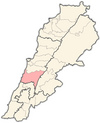Chouf District
Chouf District
جبل الشوف | |
|---|---|
District | |
 Chouf Mountains | |
 Location in Lebanon | |
| Coordinates: 33°41′44″N 35°34′49″E / 33.69556°N 35.58028°E | |
| Country | |
| Governorate | Mount Lebanon Governorate |
| Capital | Beiteddine |
| Area | |
| • Land | 191 sq mi (495 km2) |
| Population | |
• Estimate (31 December 2017) | 231,427 |
| Time zone | UTC+2 (EET) |
| • Summer (DST) | UTC+3 (EEST) |
Chouf (also spelled Shouf, Shuf or Chuf; Arabic: جبل الشوف, romanized: Jabal ash-Shouf) is a historic region of Lebanon, as well as an administrative district in the governorate (muhafazat) of Mount Lebanon.
Geography
[edit]Located south-east of Beirut, the region comprises a narrow coastal strip notable for the Christian town of Damour, and the valleys and mountains of the western slopes of Jabal Barouk, the name of the local Mount Lebanon massif, on which the largest forest of Cedars of Lebanon is found. The mountains are high enough to receive snow.
History
[edit]


The Emirs of Lebanon resided in Chouf, most notably Druze Emir Fakhr al-Din II, who attained considerable power and autonomy from the Ottoman Empire in the 17th century. He is often referred to as the founder of modern Lebanon although his area of influence and control included parts of Palestine and Syria. Another emir is Bachir Chehab II, who built the palace of Beiteddine during the first half of the 19th century. Deir al Qamar (the monastery of the Moon) is also in the Chouf region.
The relationship between the Druze and Christians in Chouf was characterized by peaceful coexistence.[2] In the early eighteenth century, the communities lived side by side in relative harmony.[3]
However, in 1848, 1860, and again in 1983-1984, during the Lebanese Civil War (Mountain War, Arabic: Harb el-Jabal), fighting broke out between the Christian and Druze communities in the Chouf.
At the end of January 1989, Druze leader Walid Jumblatt, who lived at the Jumblatt palace in the town of Moukhtara, came up with a plan to help Christians return to their homes after an estimated 300,000 had fled during the fighting. The initiative was supported by Dany Chamoun. In March the plan was shelved following General Michel Aoun’s blockade of the Druze port at Jieh, his shelling of Souq El Gharb and the assassination of one of Jumblatt’s top aides.[4][5] Reconciliation between the Druze and Christian communities was achieved on August 8, 2001, when the Maronite Patriarch of Antioch, Cardinal Mar Nasrallah Boutros Sfeir made a historic visit to the Chouf and met with Jumblatt.
In 1989, Israel carried out air-strikes on terrorist bases in the Chouf that were located a few yards from a school. Two militants were killed and several schoolchildren were wounded in the attack.[6]
Demographics
[edit]Despite the historical feuds between Druze and Christian Maronites and Sunni Muslims, the Chouf district is still one of the most religiously diverse regions in Lebanon. Currently, the region hosts equal proportions of Druze, Sunni Muslims, and Christians (Maronite and Greek Catholic) populations.
According to registered voters in 2014:
| Year | Christians | Muslims | Druze | ||||||
|---|---|---|---|---|---|---|---|---|---|
| Total | Maronites | Greek Catholics | Greek Orthodox | Other Christians | Total | Sunnis | Shias | Druze | |
| 2014[7] | |||||||||
Notable cities and towns
[edit]- Ainbal
- Ain Zhalta
- Ammatour
- Aanouth
- Baadarâne
- Baakline
- Barja
- Barouk
- Batloun
- Beitedine
- Bourjain
- Brih
- Bsaba
- Chhime
- Dahr El Maghara
- Damour
- Daraya
- Deir el Qamar
- Dibbiyeh
- Dmit
- Gharife
- Haret Jandal
- Fouara
- Jahlieh
- Jdaideh
- Jiyyeh
- Joun
- Kahlouniye
- Kfarfakoud
- Moukhtara
- Na'ameh
- Niha Chouf
- Rmeileh
- Serjbel
- Shheem
- Zaarourieh
See also
[edit]- Iqlim al-Kharrub, historical region located in the Chouf District
References
[edit]- ^ Panagakos, Anastasia (2015). Religious Diversity Today: Experiencing Religion in the Contemporary World [3 volumes]: Experiencing Religion in the Contemporary World. ABC-CLIO. p. 99. ISBN 9781440833328.
- ^ a b Hazran, Yusri (2013). The Druze Community and the Lebanese State: Between Confrontation and Reconciliation. Routledge. p. 32. ISBN 9781317931737.
the Druze had been able to live in harmony with the Christian
- ^ Deeb, Marius (2013). Syria, Iran, and Hezbollah: The Unholy Alliance and Its War on Lebanon. Hoover Press. ISBN 9780817916664.
the Maronites and the Druze, who founded Lebanon in the early eighteenth century.
- ^ Middle East International No 343, 3 February 1989, Publishers Lord Mayhew, Dennis Walters MP; Jim Muir pp.3,4
- ^ Middle East International No 346, 17 March 1989, Publishers Lord Mayhew, Dennis Walters MP; Jim Muir pp.6,7
- ^ jets hit Beirut schoolyard
- ^ https://lub-anan.com/المحافظات/جبل-لبنان/الشوف/المذاهب/

